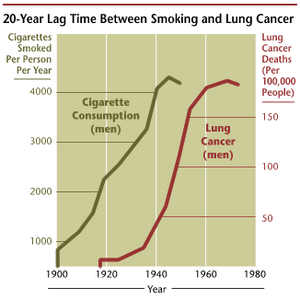Lung cancer
Lung cancer is a malignant tumour of the lungs. Most commonly it is bronchogenic carcinoma (about 90%). Lung cancer is the most lethal malignant tumour worldwide, causing up to 3 million deaths annually. Only one in ten patients diagnosed with this disease will survive the next five years. Although lung cancer was previously an illness that affected predominately men, the lung cancer rate for women has been increasing in the last few decades, which has been attributed to the rising ratio of female to male smokers. more...
The most important risk factor for lung cancer is tobacco smoking.
Treatment and prognosis depend upon the histological type of cancer and the stage (degree of spread). Possible treatment modalities include surgery, chemotherapy) and/or radiotherapy.
Signs and symptoms
Symptoms that suggest lung cancer include:
- dyspnea (shortness of breath)
- hemoptysis (coughing up blood)
- chronic cough
- wheezing
- chest pain
- cachexia (weight loss), fatigue and loss of appetite
- dysphonia (hoarse voice)
- clubbing of the fingernails (uncommon)
If the cancer grows into the lumen it may obstruct the airway, causing breathing difficulties. This can lead to accumulation of secretions behind the blockage, predisposing the patient to pneumonia.
Many lung cancers have a rich blood supply. The surface of the cancer may be fragile, leading to bleeding from the cancer into the airway. This blood may subsequently be coughed up.
Depending on the type of tumor, so-called paraneoplastic phenomena may initially attract attention to the disease. In lung cancer, this may be Lambert-Eaton myasthenic syndrome (muscle weakness due to auto-antibodies), hypercalcemia and SIADH. Tumors in the top (apex) of the lung, known as Pancoast tumors, may invade the local part of the sympathetic nervous system, leading to changed sweating patterns and eye muscle problems (a combination known as Horner's syndrome), as well as muscle weakness in the hands due to invasion of the brachial plexus.
In many patients, the cancer has already spread beyond the original site by the time they have symptoms and seek medical attention. Common sites of metastasis include the bone, such as the spine (causing back pain and occasionally spinal cord compression) and the brain.
Diagnosis
Performing a chest X-ray is the first step if a patient reports symptoms that may be suggestive of lung cancer. This may reveal an obvious mass, widening of the mediastinum (suggestive of spread to lymph nodes there), atelectasis (collapse), consolidation (infection) and pleural effusion. If there are no X-ray findings but the suspicion is high (e.g. a heavy smoker with blood-stained sputum), bronchoscopy and/or a CT scan may provide the necessary information. In any case, bronchoscopy or CT-guided biopsy is often necessary to identify the tumor type.
If investigations have confirmed lung cancer, scan results and often positron emission tomography (PET) are used to determine whether the disease is localised and amenable to surgery or whether it has spread to the point it cannot be cured surgically. PET is not useful as screening, as not all malignancies are positive on PET scan (such as bronchoalveolar carcinoma), and lung infections may be positive on PET Scan.
Read more at Wikipedia.org



